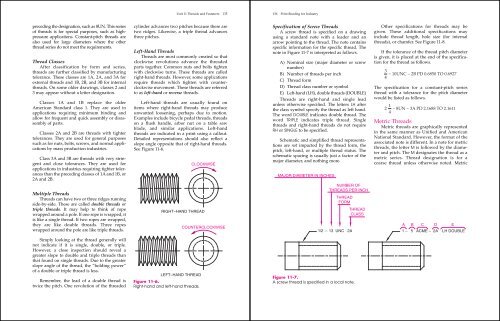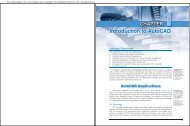THREADS AND FASTENERS - Goodheart-Willcox
THREADS AND FASTENERS - Goodheart-Willcox
THREADS AND FASTENERS - Goodheart-Willcox
You also want an ePaper? Increase the reach of your titles
YUMPU automatically turns print PDFs into web optimized ePapers that Google loves.
preceding the designation, such as 8UN. This series<br />
of threads is for special purposes, such as highpressure<br />
applications. Constant-pitch threads are<br />
also used for large diameters where the other<br />
thread series do not meet the requirements.<br />
Thread Classes<br />
After classification by form and series,<br />
threads are further classified by manufacturing<br />
tolerance. These classes are 1A, 2A, and 3A for<br />
external threads and 1B, 2B, and 3B for internal<br />
threads. On some older drawings, classes 2 and<br />
3 may appear without a letter designation.<br />
Classes 1A and 1B replace the older<br />
American Standard class 1. They are used in<br />
applications requiring minimum binding and<br />
allow for frequent and quick assembly or disassembly<br />
of parts.<br />
Classes 2A and 2B are threads with tighter<br />
tolerances. They are used for general purposes<br />
such as for nuts, bolts, screws, and normal applications<br />
by mass production industries.<br />
Class 3A and 3B are threads with very stringent<br />
and close tolerances. They are used for<br />
applications in industries requiring tighter tolerances<br />
than the preceding classes of 1A and 1B, or<br />
2A and 2B.<br />
Multiple Threads<br />
Threads can have two or three ridges running<br />
side-by-side. These are called double threads or<br />
triple threads. It may help to think of rope<br />
wrapped around a pole. If one rope is wrapped, it<br />
is like a single thread. If two ropes are wrapped,<br />
they are like double threads. Three ropes<br />
wrapped around the pole are like triple threads.<br />
Simply looking at the thread generally will<br />
not indicate if it is single, double, or triple.<br />
However, a close inspection should reveal a<br />
greater slope to double and triple threads than<br />
that found on single threads. Due to the greater<br />
slope angle of the thread, the “holding power”<br />
of a double or triple thread is less.<br />
Remember, the lead of a double thread is<br />
twice the pitch. One revolution of the threaded<br />
Unit 11 Threads and Fasteners 135<br />
cylinder advances two pitches because there are<br />
two ridges. Likewise, a triple thread advances<br />
three pitches.<br />
Left-Hand Threads<br />
Threads are most commonly created so that<br />
clockwise revolutions advance the threaded<br />
parts together. Common nuts and bolts tighten<br />
with clockwise turns. These threads are called<br />
right-hand threads. However, some applications<br />
require threads which tighten with counterclockwise<br />
movement. These threads are referred<br />
to as left-hand or reverse threads.<br />
Left-hand threads are usually found on<br />
items where right-hand threads may produce<br />
unwanted loosening, perhaps due to motion.<br />
Examples include bicycle pedal threads, threads<br />
on a flush handle, arbor nut on a table saw<br />
blade, and similar applications. Left-hand<br />
threads are indicated in a print using a callout.<br />
Detailed representations should also reflect a<br />
slope angle opposite that of right-hand threads.<br />
See Figure 11-6.<br />
CLOCKWISE<br />
RIGHT–H<strong>AND</strong> THREAD<br />
LEFT–H<strong>AND</strong> THREAD<br />
Figure 11-6.<br />
Right-hand and left-hand threads.<br />
COUNTERCLOCKWISE<br />
136 Print Reading for Industry<br />
Specification of Screw Threads<br />
A screw thread is specified on a drawing<br />
using a standard note with a leader and an<br />
arrow pointing to the thread. The note contains<br />
specific information for the specific thread. The<br />
note in Figure 11-7 is interpreted as follows.<br />
A) Nominal size (major diameter or screw<br />
number)<br />
B) Number of threads per inch<br />
C) Thread form<br />
D) Thread class number or symbol<br />
E) Left-hand (LH), double threads (DOUBLE)<br />
Threads are right-hand and single lead<br />
unless otherwise specified. The letters LH after<br />
the class symbol specify the thread as left hand.<br />
The word DOUBLE indicates double thread. The<br />
word TRIPLE indicates triple thread. Single<br />
threads and right-hand threads do not require<br />
RH or SINGLE to be specified.<br />
Schematic and simplified thread representations<br />
are not impacted by the thread form, the<br />
pitch, left-hand, or multiple thread status. The<br />
schematic spacing is usually just a factor of the<br />
major diameter, and nothing more.<br />
MAJOR DIAMETER IN INCHES<br />
NUMBER OF<br />
<strong>THREADS</strong> PER INCH<br />
THREAD<br />
FORM<br />
THREAD<br />
CLASS<br />
1/2 – 13 UNC 2A<br />
Figure 11-7.<br />
A screw thread is specified in a local note.<br />
Other specifications for threads may be<br />
given. These additional specifications may<br />
include thread length, hole size (for internal<br />
threads), or chamfer. See Figure 11-8.<br />
If the tolerance of the thread pitch diameter<br />
is given, it is placed at the end of the specification<br />
for the thread as follows.<br />
3<br />
− 10UNC − 2B PD 0.6850 TO 0.6927<br />
4<br />
The specification for a constant-pitch series<br />
thread with a tolerance for the pitch diameter<br />
would be listed as follows.<br />
1<br />
− 8UN − 3A PD 2.1688 TO 2.1611<br />
4 2<br />
Metric Threads<br />
Metric threads are graphically represented<br />
in the same manner as Unified and American<br />
National Standard. However, the format of the<br />
associated note is different. In a note for metric<br />
threads, the letter M is followed by the diameter<br />
and pitch. The M designates the thread as a<br />
metric series. Thread designation is for a<br />
coarse thread unless otherwise noted. Metric<br />
A B C D E<br />
1 – 5 ACME – 2A LH DOUBLE

















